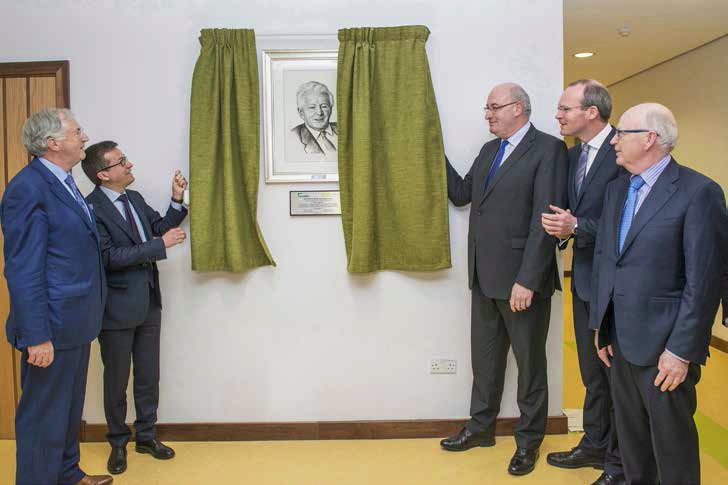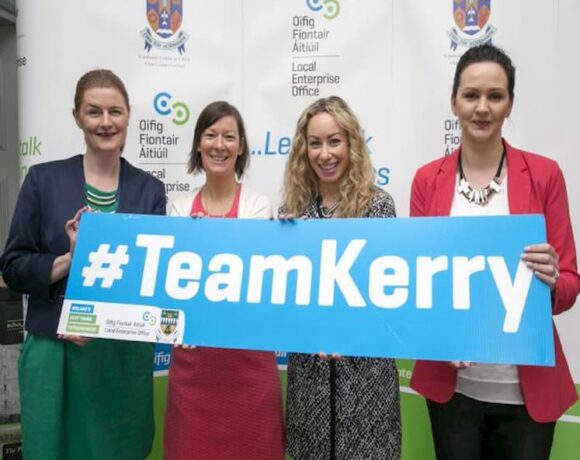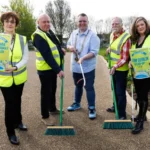When he passed away in 2013, Paddy O’Keeffe had been a iconic and legendary figure in Irish farming for many decades. Editor of the Farmer’s Journal for 37 years, O’Keeffe was a crucial figure in the modernisation of Irish farming, characterized by his love of new ideas and great passion for maximising farming practise through sound scientific research. There’s no doubt that Paddy would have loved to be around to witness the massive expansion which will sweep the Irish dairy sector in the next few years, but a centre marking his legacy will be crucial in driving new research and innovation forward, and preparing farmers for this highly competitive and exciting era. Located at the Teagasc campus in Moorepark, Fermoy, Co Cork, the Paddy O’Keeffe Innovation Centre for Grassland and Dairying was officially opened earlier this year.
Speaking at the opening of the centre, EU Commissioner for Agriculture and Rural Development Phil Hogan said: “The late Paddy O’Keeffe is really one of the legends of Irish agriculture. His passion for innovation, for change, for development, for productivity, and ultimately the sustainability of Irish agriculture and the rural way of life are values more important today than ever before, as we enter a new era of Irish, and indeed European, agriculture.”
In the year which saw the abolition of EU milk quotas, presenting Irish dairy farmers with a unique opportunity to finally reap the advantages of a burgeoning and ever-expanding global demand, Hogan’s sentiment is unquestionable: we are entering a time of incredible opportunity which offers huge returns to co-ops, family farming units, and the national economy as a whole. As a innovation initiative which combines education, research, and knowledge-transfer in the one location, the Paddy O’Keeffe centre is a crucial component in insuring that this huge expansion is well-managed and Irish competitiveness maintained, on both a national and farm level. We talked to Dr. Pat Dillon, Head of Teagasc’s Animal and Grassland research programme, about the expansion of Irish dairy markets, and the crucial role the Paddy O’Keeffe Centre will play in training farmers to remain competitive and profitable in this new, market-driven era.
Can you tell us a little bit about the Paddy O’Keeffe Centre?
The centre is about innovation. That’s how Paddy O’Keeffe would have liked to have it. He was great man in his own era, and he was all about innovation, and using it to make family units more profitable, and to enjoy a higher standard of lifestyle, become moreefficient, and that’s what it’s all about. The Paddy O’Keeffe Centre cost about 4 ½ million, 2 million of which was externally funded through FBD Trust, and the remainder was Tagasc and Department of Agriculture funding.
The background to the Centre is really the abolition of quotas – there will be a big increase in milk production – with that we will see a requirement for increased research and training and education of young people, and also increased training for existing farmers, especially in relation to expansion. One role for the centre is to support our ongoing research programme – our research programme had expanded quite a lot in recent years, and we were working from prefabs, so this accommodates our research much better. We have about 40 post graduates doing Ph.ds and fellowships here as part of the programme – and now they are accommodated in the centre, along with some of our contract researchers as well.
The principal of having research, education, and knowledge transfer in the one organisation is critical. In terms of education, we have two programmes run here, one which is run jointly with UCD – its a level 8 honours degree where the students spend six months of their third year here in Morepark. Another new programme which we started recently is the professional dairy farm management course which is training young farmers for managing large dairy units.
What role does the Department of Agriculture play in supporting innovative initiatives like the Paddy O’Keeffe Centre?
We have a core budget from the Department of something in the region of 100 million which is for Teagasc as a whole. If you look at our research budget at the moment, it about 50% co-funded with the Department, and the other 50% is competitive funding. A section of that competitive funding is also managed through the Department of Agriculture, so you compete with universities and other institutes for that. So, we work very much hand in hand with the Department.
Why is there so much optimism surrounding the dairy sector at present?
You hear a lot of talk about the dairy industry going forward and the potential of that. We’re big in terms of exports, and they talk about the 50% increase in milk production by 2020, which is worth about 1.5 billion to the Irish economy on an annual basis, but it’s also very important that the operators are happy, and that the farmers on the ground make a profit out of it. So that’s why the technology and the research is so important. We’re just out of the quota era now – it ended on the 1st of April this year, and I get feedback from some of the co-ops that milk production is up somewhere around 15 to 20% at the moment.
That’s in a very short period of time. But the co-ops and the whole dairy industry have also invested big money – there’s almost €1 billion invested by the dairy processing industry in the last four to five years – in building up new processing capacity. For example, we saw the big launch of the Glanbia plant in New Ross, and Dairygold have done the same thing, they’ve all done the same. So, there’s a lot of money invested in this, both at industry-level and farm-level, and at farm-level the investment would be even larger. So, it’s important that this is done right.
Do you think Ireland is in a particularly good position to benefit from the abolition of the quotas?
Yes. We are competitive, we have a comparative advantage in terms of what we produce, and our systems are sustainable. However, it all comes down to this increase in world demand for dairy products. The increase is all driven by developing markets in Asia, China, and Africa. Every analysis which has been carried out in the past three or four years have all repeated the same conclusion: that the increased demand will be sustained, that will it continue into the future.
So, based on that premise, by being competitive, we have a comparative advantage. There are, however, things we have to be careful about, in terms of the environment, and we also have to produce high quality products. When you’re exporting to somewhere like China, you can’t have any hiccups in terms of the quality of the product. So all those issues are critical.
What kind of challenges do Irish farmers face in adapting to this increasingly competitive, market orientated global situation?
Expansion is high risk. The overall outlook for dairy products is good – world demand is increasing by 2½ % per year. Every extra litre of milk that we produce in Ireland is exported. We know that only a small amount – about 8 to 10 % – of the milk worldwide is traded internationally, so any increase will cause fluctuation in demand, and so you’re going to get ups and downs in terms of milk price. If we take the dairy industry in Ireland, it’s very much based around family units and our system is very competitive, but they still have to make a living every year, and they have to able to financially expand, so technology is critical.
There’s a strong relationship between productivity and farming. If you look at the three key elements in our system, it’s pasture-based, we’re competitive, we can grow a lot of pasture and covert it into milk, and the type of genetics that we use. The other component is the people that work on it, the people that operate the system, and the skills and the training is vital. So it’s all those three coming together. If we don’t innovate, we die. Innovation drives the whole system.
The innovations come around in our pasture-based system and our types of genetics and so on – so innovation is critical. Helping farmers to keep up with all this change is the role of the Paddy O’Keeffe centre, in terms of research and from an educational point of view, and for training farmers and upskilling existing dairy farmers, and that is part of the solution to the challenges.
Have we good strategies in place to deal with market volatility and price fluctuations?
Yes. Some of the co-ops have been introducing average pricing policies, for example. The real big place all this has to be addressed is at farm level. We know that we are very competitive in producing milk and keeping our costs down. One of the dangers is that farmers would go into high-cost systems, and then we’re not competitive compared to the Americans, or the Dutch.
We can’t compete with them in terms of high-cost, high-input systems. If we move away from a pasture-based system to a higher-concentratesystem, we’ve no competitive advantage. But we have the advantage in producing it from our own raw material which is grazed grass.
It there a possibility that the benefits of expansion might leave some of the smaller farmers behind?
No, I think the unique thing about it in the Irish context is that a small operation can be very competitive, and a small family unit with 60 to 80 cows, run with a low-cost system, can be very profitable. That’s the one big plus: size is not the solution to everything. Your cost base is how efficient you are. You don’t have to be large to make a good living out of it. So, overall, I think that this is a good story for the country, for rural areas, and dairy farmers who are scattered all over the country. In terms of the amount that’s going into expansion, and job creation, it’s a very positive story.
Main Picture: Michael Berkery, Chairman, FBD, Carlos Moedas, EU Commissioner for Research, Science, and Innovation, Phil Hogan, EU Commissioner for Agriculture and Rural Development, Simon Coveney, Minister for Agriculture, Food, and the Marine, and Dr. Noel Cawley, Teagasc Chairman, Pictured at the official opening of the Paddy O’Keeffe Centre for Innovation.













